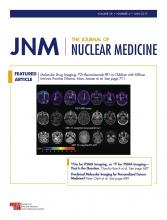Prostate-specific membrane antigen (PSMA) is a type II transmembrane glycoprotein with enzymatic carboxypeptidase activity. Expression is seen at low levels in the brain, kidneys, salivary glands, small intestines, and normal prostatic tissue (4,5). However, the function of this enzyme, also called glutamate carboxypeptidase II, in prostate cancer is still unclear (4). Compared with its normal expression, PSMA is highly overexpressed in prostate cancer cells. The level of PSMA expression rises with increasing tumor dedifferentiation as well as in metastatic and hormone-refractory cancer (5–7), making PSMA an ideal imaging and therapeutic target for prostate cancer.
Several radiolabeled small-molecule inhibitors of PSMA have been designed (8). Currently, the most widely used PET tracer is the low-molecular-weight PSMA inhibitor 68Ga-PSMA-11 (9), but it may have some disadvantages with respect to production capacity and nuclear decay properties. Its main advantage is the commercial availability of 68Ga via 68Ge generators, allowing convenient batch production of approximately 2–4 patient doses per generator elution. For centers that do not have access to a cyclotron and have a moderate number of examinations, these generators present a reasonably priced upfront investment. PSMA-11 contains the chelator HBED-CC (N,N′-bis [2-hydroxy-5-(carboxyethyl)benzyl] ethylenediamine-N,N′-diacetic acid), which allows labeling with kit formulations at ambient temperature without critical radiochemistry demands (10,11). However, 68Ga has a physical half-life of only 68 min. Therefore, 68Ga-PSMA-PET scans are preferably performed in house, and delivery of sufficient tracer activities to remote centers is challenging. Consequently, in large centers with many patients, several productions per day are required (12), or multiple generators need to be operated simultaneously, multiplying costs. To meet the quantitative demand of those centers, the use of 18F-labeled PSMA tracers may overcome these limitations. PET radiopharmacies with an on-site cyclotron can produce high activities of 18F at moderate costs. The physical half-life (110 min) of 18F-labeled PSMA tracers such as PSMA-1007 (((3S,10S,14S)-1-(4-(((S)-4-carboxy-2-((S)-4-carboxy-2-(6-18F-fluoronicotinamido)butanamido)butanamido)methyl)phenyl)-3-(naphthalen-2-ylmethyl)-1,4,12-trioxo-2,5,11,13-tetraazahexadecane-10,14,16-tricarboxylic acid)) and DCFPyL (2-(3-{1-carboxy-5-[(6-18F-fluoro-pyridine-3-carbonyl)-amino]-pentyl}-ureido)-pentanedioic acid) may also enable centralized production and delivery to distant satellite centers. 18F also has a lower positron energy than 68Ga (0.65 vs. 1.90 MeV), theoretically resulting in an improved spatial resolution (13). Table 1 compares PET tracers labeled with 18F and 68Ga.
Comparison of 68Ga and 18F
Two promising 18F-labeled PSMA tracers are under clinical investigation: 18F-DCFPyL and 18F-PSMA-1007. A few studies have evaluated 18F-DCFPyL in the setting of recurrent prostate cancer or biochemical relapse (14–16), but there are no published data on primary prostate cancer, and in only a subgroup of patients were the imaging results confirmed by histopathologic evaluation. For 18F-PSMA-1007, one proof-of-concept study examined the tracer in 10 patients with primary high-risk prostate cancer, most of whom had lymph node metastases, which were systematically evaluated histopathologically (17). Only case reports—although interesting—have been published, one in a patient with biochemical relapse (17) and another in an advanced-stage patient who required tailoring of PSMA radioligand therapy (18). 18F-PSMA-1007 was reported favorable for primary tumors and local relapse because of low clearance via the urinary tract (1.2 percentage injected dose over 2 h). In contrast, urinary excretion of 18F-DCFPyL, 68Ga-PSMA-11, and 68Ga-PSMA-617 is remarkably higher (>10 percentage injected dose over 2 h) (1,16,19). However, this improvement is related less to the radiolabeling moiety than to the optimized structure of the overall molecule. Thus, the published experience with 18F-PSMA ligands is still limited to about 100 patients in different clinical settings. In contrast, confirmative publications from different centers, reporting on several thousand patients examined with 68Ga-PSMA-11, present a robust basis by which to gauge the value and limitations of these radionuclide–ligand combinations (3,20).
Intraindividual comparisons between 68Ga- and 18F-labeled ligands is limited to 25 patients (21); a separate cohort of 62 patients with biochemical relapse who were examined with 18F-DCFPyL performed comparably to literature values for 68Ga-PSMA-11 and even slightly better than the intrainstitutional 68Ga-PSMA controls (21). As promising as these preliminary results are, they also demonstrate that larger, prospective clinical trials evaluating 18F-labeled PSMA tracers in different clinical settings are mandatory.
It is too early to answer the question of whether 68Ga or 18F should be used for prostate cancer imaging. Both should be considered widely exchangeable for most clinical indications (Table 1). Today the question is more one of whether it is decentralized or centralized production that is needed to adequately meet the clinical demand.
DISCLOSURE
Frederik L. Giesel and Kopka Klaus have applied for a patent for PSMA-1007. No other potential conflict of interest relevant to this article was reported.
Footnotes
Published online Apr. 13, 2017.
- © 2017 by the Society of Nuclear Medicine and Molecular Imaging.
REFERENCES
- Received for publication March 16, 2017.
- Accepted for publication March 20, 2017.







